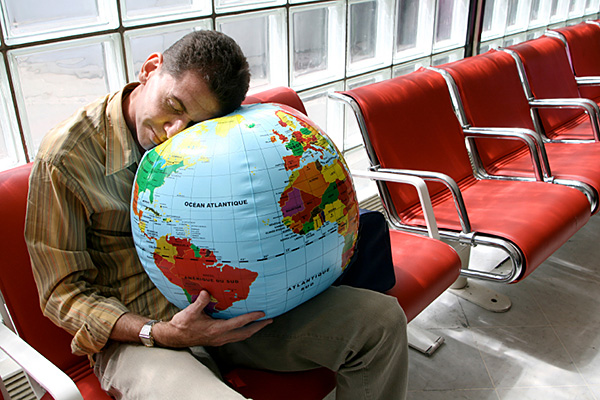Nobody enjoys feeling disoriented, nauseated, tired, and unable to concentrate or sleep. But with a few simple precautions, you can vastly reduce your jet lag symptoms and enjoy a smoother transition.
What is jet lag?
Have you ever taken a long flight and arrived at your destination feeling weak, tired, or generally awful? That’s jet lag – and it’s not just your imagination. It’s a genuine physiological phenomenon. Symptoms of jet lag may include:
- fatigue
- insomnia
- loss of appetite
- disorientation
- reduced concentration
- reduced aerobic fitness
- reduced anaerobic fitness
- nausea
- GI distress
- joint swelling and stiffness
- muscle pain and stiffness
Jet lag originates in the nerve cells of the hypothalamus, the region of our brain that regulates temperature, sleep, circadian rhythms, appetite, and hunger.
This part of the brain evolved long before air travel and it responds slowly to changes in external time and light levels. This conflict between “inner time” and “outer time” is jet lag.
In fact, scientists estimate that it’ll take you one full day to recover for every hour of time difference. So, if you travel from London, UK to New York, USA, expect about five days until you feel right.
Interestingly, the direction you travel can affect the severity of your jet lag symptoms. Traveling east is more difficult on the body than traveling west. It seems to be easier for our bodies to delay our internal clocks than to speed them up.
And yes, even experienced travelers suffer from jet lag.
A 1994 New Zealand survey of international flight attendants found that while they were used to long-haul travel
- 90 percent suffered from tiredness over the first five days of arrival;
- 94 percent experienced a lack of energy and motivation;
- 93 percent reported broken sleep; and
- 70 percent had ear, nose or throat problems.
Jet lag’s no fun, but luckily, taking a few simple precautions before, during and after you travel can make an enormous difference, helping you recover much more quickly.

How to manage jet lag
Set your expectations
If you’re a frequent traveler, you may enjoy an ultra-modern jet-set life, but in terms of your body, you’re still working with old hardware.
Accept the fact that if you’re crossing several time zones, it will play a role in your travel no matter what you do, so plan accordingly.
Realize that you may not be at your best for a few days following a long trip, especially if you flew east. Set your expectations appropriately.
For instance, if you have a big business meeting on Wednesday morning in Barcelona, consider arriving a day or two in advance rather than grabbing the red-eye from Atlanta on Tuesday night.
(Besides, that gives you extra time to find an espresso and enjoy strolling Las Ramblas.)
Along with smart planning, you can dramatically reduce your symptoms with a few adjustments to your nutrition, exercise, and supplements.
Nutrition
Good news: Appropriate fasting protocols can radically reduce jet lag symptoms.
In 2002, researchers put fasting to the test with 186 National Guard personnel deployed across nine time zones. In particular, they tested the Argonne diet protocol (see below) for its effects on jet lag symptoms.
95 participants used the diet in preparation for their deployment, and 39 used it in preparation for their return. The rest just followed their regular routine.
Upon deployment, those who followed the Argonne fasting diet were 7.5 times less likely to experience jet lag upon arrival. Of the 39 who followed the protocol upon their return, they were 16.2 times less likely to experience jet lag symptoms!
The protocol adopted by this study is a little intense, and can require alternate feasting and fasting for up to four days before travel, which isn’t necessarily feasible for everyone.
But Dr. Clifford Saper created a simplified version, which PN’s own Dr. John Berardi has followed several times when he has to fly across multiple time zones in order to give presentations.
Modified Argonne Diet Protocol
On your day of travel, eat a normal breakfast and normal lunch. Then fast immediately before and especially during the flight, while drinking plenty of water to stay hydrated.
Upon arrival, eat soon after landing, as close to local meal time as possible. Then initiate a normal meal schedule based on local time. Fasting should last at least 14 hours but can last as long as 24 hours. You may need to adjust actual meal times based on your flight time.
Exercise
If you’re the kind of person who likes an outdoor morning workout, you know that exercise — especially combined with light exposure — can dramatically improve your mood and energy levels at a time of day when many people feel sluggish.
Along with carefully timed food intake, exercise can also affect our circadian rhythms. And when used appropriately, exercise can help to alleviate the symptoms of jet lag.
The best kind of exercise is any kind that you can do outdoors during daylight hours.
Light is the most powerful regulator of our internal biological clocks, so we can use light cues to help minimize jet lag. Bright light tells the body it’s time to be awake, especially when combined with movement.
Another helpful trick is to train at the same time you’d train at home. In other words, if you normally train at 8 a.m. in LA and you have traveled to London, do your best to train at 8 a.m. London time, and preferably outside.
Interestingly, training at the same time every day may have little effect on the brain’s biological clock. The main benefit seems to be that it helps our muscles and peripheral tissues synchronize with the new time zone.
Regardless, training at our usual time does seem to affect various body systems, and it certainly seems to help with jet lag.
So far, there’s not much research on the best type of exercise to reduce jet lag. But listen to your body and do what feels best.
High intensity cardio may be out of the question when you’re exhausted and every limb seems to weigh twice as much as it normally does. If that’s the case, try a light body weight workout, a walk, or some stretching exercises. Any kind of movement is probably helpful.
Do what you can, at approximately the same time as your usual routine, and preferably outside.
Supplementation
Melatonin
Melatonin is a hormone secreted by the pineal gland in the brain. One of melatonin’s key jobs is controlling the body’s circadian rhythm — the internal clock that plays an important role in when we fall asleep and when we wake up.
Melatonin release is tied to the amount of light you experience. Light suppresses its release. When it gets dark at night and we turn out the lights, melatonin release is stimulated.
Crossing time zones, we may suddenly find ourselves exposed to excessive light when ordinarily, it would be our bedtime. Even a three-hour time difference can be significant.
When this happens, our melatonin cycles become disrupted and we experience jet lag until our circadian rhythms adjust to the new environment.
That’s why melatonin supplements may help.
But dose timing is critical. Research suggests that taking melatonin before leaving for a trip makes jet lag symptoms even worse.
So wait until you land in the new time zone to supplement; this will significantly reduce jet lag symptoms, improve sleep quality, and increase alertness and recovery.
Since we know that both light exposure and melatonin supplementation can be used to shift the human circadian clock, you might wonder what happens when the two techniques are used together.
One study combined:
- a gradually advancing sleep schedule (where each participant was wakened one hour earlier each morning for three days),
- with light exposure upon waking (to simulate morning light in a new time zone),
- along with afternoon melatonin (or a placebo, for those in a control group).
The result? A gradually advancing sleep schedule, morning light exposure, and placebo caused a 1.7 hour per day shift in participants’ circadian rhythms.
But when melatonin was added to the regime, participants gained a full hour per day in circadian adjustment, up to ~2.6 hours per day.
Of note, 3 mg of melatonin was no more effective than 0.5 mg of melatonin. In other words, a very small amount of melatonin could have powerful effects.
That study and others suggest that if you want to supplement with melatonin to combat jet lag:
- take from 0.5 mg up to 5 mg of melatonin for three nights (or until adjusted);
- one hour before a normal bedtime; and
- only after you’ve reached your travel destination.
Pycnogenol
Pycnogenol is another supplement that has been studied for its ability to decrease jet lag symptoms.
When participants took 50 mg of pycnogenol three times per day for seven days, starting two days prior to travel, the average duration of jet lag symptoms decreased significantly.
A control group suffered for 39.8 hours, while those who supplemented with pycnogenol endured their symptoms for only 18.2 hours.
Why? Perhaps because pycogenol significantly reduced cerebral edema or swelling, as well as edema of the limbs.
As a result, those who supplemented with pycnogenol had fewer short- term memory problems, fewer problems with cardiac function and blood pressure, and also reported far less fatigue
Interestingly, pycnogenol supplementation has also been shown to decrease deep vein thrombosis and superficial vein thrombosis – common side effects of long flights.
In fact, in one study of people who were at moderate to high risk for such events, pycnogenol decreased the incidence of thrombosis from 5.15% to 0%.
Conclusion
As long as humans continue to travel long distances by air, jet lag’s probably a fact of life. But luckily, there’s a lot you can do to prevent and reduce it.
Before you go
To begin with, try adjusting your wake and sleep cycle as close as possible to your destination’s time zone. This involves waking up and going to bed one hour progressively earlier or later (depending on which way you’re traveling) each day for three days.
If you’re travelling east, wake up an hour earlier each day for three days. If you’re travelling west, do the reverse. You can visit JetLagRooster to help you determine your schedule.
Get bright light during your day. You can use an artificial light box if you own one, or better yet, you can get outdoors. At minimum, you can sit near a window.
If you choose to fast, start about 14-24 hours before your next planned meal in your new time zone.
Consider supplementing with 50 mg of pycnogenol three times a day, starting two days before your trip.
While you’re still fresh and full of energy, try a higher intensity workout before your flight to burn some calories and prevent travel stress. If possible, do this at your usual workout time.
Of course, if you have a very early flight, you may not have time for a full workout, but a few brisk laps around the airport before boarding will work just fine.
While traveling
Stay well hydrated and continue your fast.
If possible, get up and move about the cabin often, at least once every hour to promote blood flow and inhibit swelling.
(Tip! The little space by the bathrooms has enough space for some squats. Just don’t kick the drink cart.)
Avoid alcohol and caffeine because alcohol can dehydrate you and caffeine may affect your circadian rhythms.
Upon landing
Expose yourself to sunlight and social interaction. The worst thing you can do is go into a dimly lit hotel room and watch TV.
Consider taking a nap if you need to, but only if you can limit it to 30 or 40 minutes. The worst thing you can do is hop into bed the minute you arrive and stay there for hours.
Expose yourself to light as quickly as possible upon waking each morning in your new location.
Consider taking 0.5 (or up to 5mg) of melatonin for three nights or until adjusted, one hour before normal bedtime in your new location.
Continue taking 50 mg of pycnogenol three times per day for up to five days after landing (up to a total of seven days).
Try to exercise outdoors at your usual workout time. If you prefer to lift weights, you can always lift weights at your usual time, but try to follow up with a walk outside to get the best of both worlds.
And enjoy the benefits of travel without as much jet lag!
Eat, move, and live… better.©
Yep, we know… the health and fitness world can sometimes be a confusing place. Even when it comes to something as simple as shoes. But it doesn’t have to be.
Let us help you make sense of it all with this free special report.
In it you’ll learn the best eating, exercise, and lifestyle strategies — unique and personal — for you.
Click here to download the special report, for free.
References
Click here to view the information sources referenced in this article.



Share